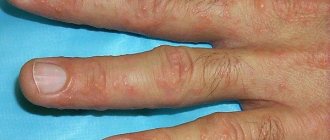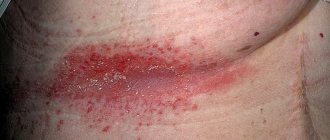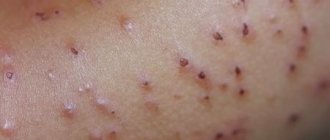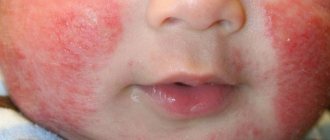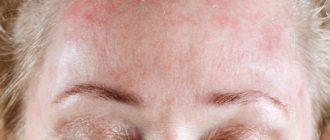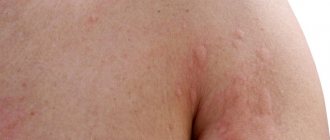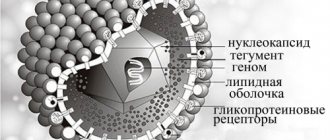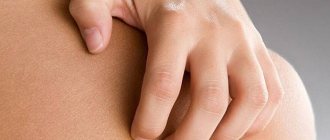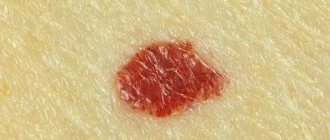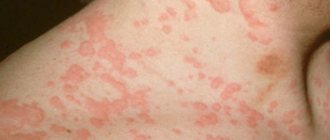The human skin contains a large number of microbes, bacteria and fungi. With good local immunity, they do not pose a threat to health. Elderly people and patients after a stroke or injury cannot take care of themselves. Most often, they are immobilized and do not fully control their body. In people who are bedridden, the condition of the outer skin changes over time, the level of collagen and fat production decreases, which leads to increased sensitivity, thinning and dryness. The skin is easily injured and takes a long time to heal, and the lack of air baths provokes new irritation and the appearance of infections and bedsores. Also, due to impaired motor function, blood stagnation occurs, as a result of which bedridden patients are diagnosed with diaper rash.
Diaper rash is an inflammatory process that occurs in areas of the skin:
- compressed for a long time;
- constantly rubbing against each other;
- in contact with linen;
- in areas of constant exposure to moisture: urine, sweat, discharge from wounds and ulcers.
Causes
The appearance of diaper rash in men in the groin area is caused by hyperhidrosis, the presence of infections on the skin of the genital organs, violation of personal hygiene rules, urine leakage due to the development of genitourinary diseases (prostatitis, adenoma), obesity, the development of diabetes mellitus and other pathologies of internal organs.
Diaper rash in older women and men can occur due to:
- allergic reaction;
- wearing synthetic clothing;
- nocturnal enuresis;
- hemorrhoids;
- vegetative-vascular dystonia;
- hormonal imbalance;
- blood stagnation;
- weakness of the immune system;
- intertriginous dermatitis;
- deficiency of nutrients.
Important! What exactly caused diaper rash on the skin can be determined by a dermatologist.
Poor hygiene
Natural body secretions that accumulate on the skin provide a breeding ground for pathogens. If water procedures are not taken on time, an inflammatory process may develop.
Excess weight
Overweight people are prone to excessive sweating. Moisture and a significant amount of subcutaneous fat increases friction of the skin in the groin area.
Wrong choice of underwear
Synthetic materials do not allow or absorb sweat, which leads to increased moisture in the epidermis.
For what reasons do fungal diaper rashes appear and how to distinguish them from allergies?
When certain areas of the skin become inflamed, diaper rash may develop; the fungus is caused by microorganisms that have spread to the damaged surface. Inflammation of the skin occurs as a result of friction with tight and breathable clothing and prolonged contact with sweat, which corrodes the upper layer of the epidermis. Folds on the body are prone to diaper rash: between the buttocks, under the breasts, between the toes, in the neck, folds on the stomach and groin. The problem occurs especially often in children and obese people.
Mechanism of development of deviation
The inflammatory process leading to the formation of diaper rash in the groin in women and men of any age begins as a result of friction of the surface of the epidermis against clothing/bed, increased sweating, increased humidity, a large volume of sebum, and overheating of the body.
The most susceptible to dermatological disorders are:
- babies;
- aged people;
- bedridden patients;
- obese people;
- sloppy people who neglect to care for their own bodies;
- people suffering from hyperhidrosis.
Under certain conditions, an inflammatory process on the skin can develop anywhere where there are skin folds.
Severity of intertriginous dermatitis or diaper rash under the arms
The skin may become red or bruised
Diaper rash has several degrees:
- Slight redness of the skin, discomfort in the affected area of the skin, slight itching. No obvious injuries.
- Painful injuries, noticeable redness of the skin, and the appearance of various rashes appear.
- The appearance of erosions, ulcers. There is also a deterioration in health, fever, and intoxication.
Frequent localizations
The appearance of unpleasant symptoms can be observed:
- in the armpits;
- on the feet, ankles;
- in the area under the abdomen;
- between the buttocks and in the anal area;
- on the buttocks and in the tailbone area.
Diaper rash in older women and younger representatives of the fairer sex occurs under the breasts, as well as in the vaginal area. Men with a similar problem can encounter not only in the groin, but also on the scrotum and penis.
Symptoms
There is no particular need to talk about what diaper rash looks like.
Let us recall the main symptoms:
Diaper rash in adults can appear everywhere, but most often they occur on the skin in the groin, between the buttocks, under the mammary glands, in the armpits, and between the toes.
What do diaper rashes look like? This condition can lead to:
- red or reddish-brown rash
- sores, itching or oozing sores
- unpleasant smell
- cracks or crusting of the skin
The most vulnerable to diaper rash are the lower abdomen (under the so-called “apron” for overweight people), the gluteal region, and the areas around the genitals. The cervical, axillary, femoral and inguinal folds become inflamed less frequently.
Diaper rash is classified according to one of three degrees:
- mild - the skin turns slightly red, but its integrity is not compromised; - medium - noticeable redness with erosions (superficial defects of the epithelial layer); - severe - the inflamed skin has a bright red tint, because the erosions are combined with each other. Ulcerations may occur.
The initial manifestation of diaper rash is erythema, or redness, which subsequently spreads to adjacent, healthy areas. The folds are covered with microcracks.
They don't bleed. After the stratum corneum falls off, wounds with blurred contours form.
Possible complications are yeast fungus, streptococcal infection.
Streptococcus most often settles in the folds behind the ears. Yeast and mixed forms of diaper rash are found between the buttocks and in the inguinal-femoral folds.
Infectious forms manifest themselves in complex ways. Large foci of erythema with clear contours may include fluid-filled infiltrates.
They are surrounded by a thin keratinized layer. Over time, this collar peels off.
Dryness and smoothness of the integument is not necessary: sometimes they are moist, covered with crust and scales. The epidermal (top) layer of skin loses its integrity.
Severe pain and a burning sensation are characteristic sensations of patients.
If diaper rash is prolonged, then there is a possibility of it turning into microbial eczema. The disease is characterized by large, intensely itchy lesions with uneven rims.
Types of diaper rash
Based on the cause of diaper rash, treatment tactics are determined.
In medicine there are:
- Weeping diaper rash. The most common type of disease, caused by the accumulation of moisture in the folds of the epidermis. In the absence of the necessary measures to combat the dermatological defect, infections can join the inflammation. A pronounced symptom of weeping diaper rash is itching.
- Diaper rash as a companion to diabetes. When metabolism is disturbed, the epidermis most often suffers. They are easily irritated by both internal and external factors. Due to the inability of the body's cells to fully absorb glucose, the activity of all internal organs and systems is disrupted. As a result, the skin constantly peels off, becomes inflamed, itches, and disruptions in thermoregulation occur.
- Streptococcal and fungal diaper rash. Their appearance is provoked by the penetration of pathogenic microorganisms into the epidermis. This disease is caused by malfunction of the sebaceous glands, obesity, and genetic predisposition. Accompanied by the formation of pustular rashes and bright red spots. Location: any part of the body. Often observed in the groin of adult men.
- Yeast is a consequence of the activity of Candida fungi. Therefore, doctors often call this disease superficial candidiasis. The inflammatory process often occurs against the background of cancer pathologies or after injuries. The main symptoms are the presence of a blistering rash that merges and forms erosion.
Degrees of development
There are three degrees of damage.
Mild degree
It appears as slight redness on the body with no deep wounds, ulcers, erosions, or cracks.
Average degree
It is characterized by severe redness, the appearance of erosive ulcerations, and inflamed pimples. Photos of similar damage can be seen on the Internet.
Severe degree
Accompanied by bright, weeping foci of inflammation, erosions, combined into large foci. The patient experiences itching in the affected area, an unpleasant odor, cracks, and bloody discharge from the wounds.
If a secondary infection joins the pathological process, the condition of the epidermis rapidly worsens. Multiple erosive formations appear with sticky discharge and a repulsive odor. A person complains of discomfort, itching, burning, pain.
Complications
In the absence of appropriate timely treatment for diaper rash, cracks and bleeding non-healing ulcers form in the affected areas, and the skin becomes covered with a gray-brown coating that emits a putrid odor. When bacteria enter open wounds, the disease becomes chronic. The patient constantly experiences itching, burning and severe pain in the areas where the ulcers form. The physical and psycho-emotional state of health worsens. In such cases, in order to cure the disease, expensive, potent drugs are prescribed. The most common complications are fungal diseases, streptococcal infections, and athlete's foot.
Diaper rash in pregnant women
The formation of diaper rash on the body of expectant mothers is quite common. This is due to the fact that the skin is exposed to additional irritating factors against the background of changing hormonal imbalances and weight gain.
Causes
The following can cause diaper rash in the groin area or anywhere else in the skin folds of women during pregnancy:
- high body temperature;
- urinary incontinence;
- insufficient hygiene;
- overweight;
- clothes that are too tight, made from low-quality materials;
- allergies to cosmetics or powder.
Symptoms
As in the groin of men, the signs of diaper rash in pregnant women are no different: the sore spot turns red, begins to hurt, and itch. Nervousness, irritability, and insomnia appear, triggered by constant discomfort on the skin.
Treatment during pregnancy
At the initial stage, it is not difficult to cure diaper rash in the groin.
The expectant mother should:
- carry out hygiene procedures more thoroughly using hypoallergenic detergents;
- stop wearing synthetics;
- take air baths after taking a shower.
how to cure advanced inflammation. He appoints:
- antiseptic solutions;
- healing creams and ointment compositions;
- antibiotics (if there is tissue infection);
- antihistamines;
- antifungal medications.
You can use folk remedies, but before doing this it is advisable to consult a gynecologist.
Treatment for diaper rash between toes
Damage to the toes is the result of mechanical stress, non-compliance with personal hygiene rules and fungal infection. Treatment of pathology involves following the rules:
- you need to regularly wash your feet thoroughly with soap;
- you need to buy any antiseptic at the pharmacy and lubricate your fingers with it, then blot them with a dry cloth;
- socks should be made from natural materials. In addition, they must always be clean;
- If possible, you should go barefoot. But this does not apply to public places, fungus is common there;
- you can buy a cream with a drying effect and lubricate your fingers 2-3 times a day;
- Tar soap actively fights fungus. It can be used when bathing instead of the usual cosmetic product. If its smell bothers you, you can buy scented tar soap, which smells pleasant;
- You can lubricate your toes with sea buckthorn oil without washing it off. It is advisable to apply the oil at night; by morning it will be absorbed.
It is important to accurately determine the original source of the pathology. Perhaps diaper rash in the area of the toes and feet is the result of improper functioning of the internal organs. Then the problem requires medical intervention. Diaper rash between the toes is the most common occurrence.
Diagnostics
Before deciding how to remove diaper rash in the groin, you need to see a dermatologist. It is especially important to consult a specialist when the disease becomes advanced. Symptoms of diaper rash in women and men in the groin, buttocks, and armpits are often similar to signs of other dermatological diseases. Therefore, the patient is referred for a laboratory examination of the dermis by scraping the eroded areas.
Based on the test results, a diagnosis is established and therapy is prescribed. Additionally, a general blood and urine test may be required, as well as bacterial culture for fungi and bacteria.
Birch buds
The raw materials (100 g) are passed through a meat grinder or crushed in a blender, then mixed with Vaseline (50 g). Lubricate the affected areas with the resulting substance as needed.
Bay leaf
The spice (20 g) is ground, poured with boiling water (250 g), and left for an hour. Moisten a swab in the cooled liquid and apply to the wound.
Natural powders
Talc, crushed oak bark, and crushed buckwheat leaves are used as powders.
Starch, as one of the folk remedies for healing diaper rash, is not recommended for children. It clumps and hardens, creating an additional source of skin chafing.
Oils
The affected areas can be treated with oils: olive, sunflower, linseed . The product is used after boiling in a water bath and cooling. Fir pharmaceutical essence does not require preliminary preparation.
Application of the products to the irritated areas is carried out after water procedures and wiping dry.
Treatment options
If you notice the problem right away, it will not be difficult to cure diaper rash in the groin and body. You will need to treat the sore spot with an antiseptic. Some people use antibacterial wipes for this purpose.
You can take a bath with a herbal decoction, dry your body thoroughly and lie down undressed, taking air baths. If the situation is more serious, then it is necessary to use medications for diaper rash in adults in the groin and other parts of the body.
Important! You cannot independently prescribe antibacterial and antifungal drugs without knowing the origin of the pathological process. The wrong medicine can aggravate the condition and lead to the spread of infection throughout the body.
Ointments
If you often sweat in the area between your legs or there are signs of inflammation on your body, then how to treat diaper rash in the groin?
Ointments you can use:
- Zinc-salicylic ointment for diaper rash in people of any age (cost 25 rubles). This is a combined antiseptic used for all types of bedsores and diaper rash that are not associated with bacteria and fungi.
- Zinc ointment (costs 37 rubles). Used for weeping wounds and erosions. It has anti-inflammatory, astringent, healing properties. Dries skin perfectly. Not prescribed in the presence of an infectious process.
- Akriderm GK (cost 460 rubles). Combined antimicrobial, antifungal, antiallergic agent. It is based on a glucocorticosteroid. The drug quickly relieves inflammation, suppresses irritation, relieves swelling, itching, and burning. Used no longer than 10 days.
- Desitin (costs 290 rubles). Zinc-based ointment for diaper rash. Dries and absorbs excess moisture. Eliminates symptoms, has a beneficial effect on the activity of the sweat glands.
- Levomekol (costs 140 rubles). This is an ointment with an antibiotic that has disinfectant, anti-inflammatory, drying, and regenerating properties. Accelerates metabolism, improves the healing of the dermis, heals weeping eczema and pustules.
Creams
When choosing an effective remedy for diaper rash, you can pay attention to the following creams:
- Clotrimazole (cost 258 rubles). Antifungal cream that can be applied to infected epidermis. Apply twice a day. Additionally, tablets are taken to obtain a lasting effect.
- Bepanten (costs 775 rubles). It is made in the form of ointment and cream. Accelerates the regeneration of cracks and wounds, activates cell restoration, suppresses inflammation. Allowed for use by pregnant and nursing mothers.
- Sudocrem (cost 365 rubles) based on zinc with lanolin. It is used in the treatment of bedsores, diaper rash, burns of varying degrees of damage. Removes inflammation, dries wounds, reduces sweating, creates a barrier film, preventing tissue irritation and further spread of bacteria.
- Sanosan (price 260 rubles). Caring German therapeutic and prophylactic cosmetic product. Often used to treat and prevent groin rash in the elderly. Contains zinc and D-panthenol.
- Advantan (cost 615 rubles) cream, lotion, ointment for diaper rash in the groin and body. For weeping diaper rash, a cream form of the drug is used. This is a powerful antihistamine with a quick healing effect. Perfectly relieves inflammation and other unpleasant symptoms. Do not use for more than 10 days.
- Pantestin gel for diaper rash in adults in the groin (costs 150 rubles). It has an active antifungal and antimicrobial effect. Contains dexpanthenol - a substance with a wound-healing, anti-inflammatory effect.
Antiseptic solutions
If diaper rash is observed in the groin in men, treatment begins with antiseptic compounds. They disinfect problem areas, clean them well, and prevent the proliferation of pathogenic flora. As a result, irritating symptoms become less noticeable, and the healing process occurs faster. Chlorhexidine (costs 26 rubles), Boric acid (costs 85 rubles), Miramistin (costs 410 rubles) are considered popular
Miramistin Boric acid Chlorhexidine
Powders
If there is diaper rash in older women/men or a child, you can use talc-based powders. They instantly absorb excess moisture, prevent excessive friction, and prevent inflammation from spreading to healthy tissue. When it comes to cosmetic products, it is advisable to choose brands that do not contain fragrances or other substances that can cause an allergic reaction.
Complex drugs
Diaper rash in the groin in men, the treatment of which is no different from the skin problem that occurs in women, is eliminated with complex medications. They are especially effective in the initial stages of damage. These products are manufactured taking into account all the necessary methods of influencing problematic skin: they relieve itching, redness, swelling, cracks, and pathogenic microbes. Available in ointments, gels and solutions.
They have no serious side effects or contraindications, as they contain exclusively natural ingredients:
- La-Cri cream-gel (cost 255 rubles). Fights allergic manifestations, softens, moisturizes, heals the skin. Contains panthenol and bisabolol.
- Resin (cost 40 rubles) based on pine oil and beeswax.
- Balm Karavaev (costs 214 rubles). Consists of a mixture of plant extracts and fruits.
- Boro-plus (costs 115 rubles) is a cream with natural ingredients. Quickly heals irritated cracks and restores epidermal cells.
Zhivitsa Balsam Karavaeva Boro plus La Cree
Folk remedies
For fungal and bacterial skin lesions that cause severe diaper rash, complex treatment is required.
In other cases, folk remedies that can be done at home will help relieve unpleasant symptoms:
- shampoo is mixed with vodka in equal proportions and wiped with the resulting composition on the groin of women or men;
- mix chamomile, celandine, string, oak bark. 2 large spoons of herbal mixture are steamed in a glass of boiling water. The resulting decoction is used to wipe the lesions or add them to baths;
- stir 50 g of lard, a few drops of tea tree oil, 0.5 small spoon of yarrow powder, 5 drops of aloe juice. For skin inflammation, odor treatment is carried out twice a day after taking water procedures.
Candidiasis of large skin folds yeast intertrigo
In this article you will learn what skin candidiasis is, what types of this disease there are, and what organs it affects. And also, what symptoms indicate the presence of candidiasis, how this disease is treated, and what danger it poses.
Cutaneous candidiasis is a lesion of the upper integument of the skin, which is caused by a fungal infection of Candida. This disease manifests itself in the form of lesions of the skin of a pale red color with pronounced swelling. Most often, the process affects such areas of the skin as: axillary and groin areas, interdigital spaces and the area under the mammary glands in women. An accurate diagnosis can only be made if a skin scraping is taken and a laboratory test is performed to confirm the presence of Candida fungus. Treatment is carried out in different ways:
- local;
- general;
- use of antifungal drugs.
According to the World Health Organization, recently there has been an increase in the incidence of fungal infections, and candidiasis too. This disease can affect people of any gender and age, regardless of place of residence and working conditions. Candida fungi are considered a conditionally pathogenic flora and are present in almost every healthy organism. Their transition to a state that causes illness can be an alarming signal indicating that not everything is in order with the body.
Candidiasis is considered an endogenous infection that develops both on the surface of the skin and in the mucous membrane. The most favorable place for development is considered to be a humid environment in which, under certain circumstances, Candida yeast fungi begin to develop and divide. In small concentrations, these microorganisms are present in the body of almost every healthy person and are located in the nasopharynx, gastrointestinal tract and vagina. The progression of infection can be triggered by the following internal factors:
- diseases of the gastrointestinal tract;
- diabetes mellitus and other endocrine pathologies;
- performed operations and postoperative therapy;
- lack of vitamins;
- intoxication caused by alcohol, drugs or chemotherapy;
- long-term use of antibiotics;
- immune suppressive therapy, which is carried out after organ transplantation to reduce the likelihood of organ rejection;
- sexually transmitted diseases and AIDS;
- autoimmune processes in the body caused by both disease and medications.
As a rule, it is internal factors that can trigger the appearance of candidiasis. But in rare cases, external influences can also serve as an impetus for the development of this disease. These include.
- Wearing extremely warm clothing. This can cause increased sweating, which in turn creates an ideal environment for Candida to multiply and develop.
- Exposure of the skin to harmful substances, in particular acids and alkalis.
- Microtraumas.
- Poor hygiene.
The classification of candidiasis is determined by the localization of the process. Each type of this disease has its own specific symptoms. A common symptom that is inherent in all types of skin candidiasis is the formation of vesicles, papules, which merge into a single spot, usually pale red. The surface of the spot may have a shiny tint, be smooth and with high humidity, accompanied by itching and burning.
Or, as it is scientifically called, candidal onychia. It occurs on the surface of the nail plate. Brown spots with a brown tint appear first at the base of the nail, and then can begin to spread over the entire surface. As a result, the nail plate begins to peel, become depleted, or crumble. Women are most often affected by this localization of candidiasis.
This is a fairly rare form that affects the skin of the face. Blisters, papules, and erosions appear on it. All this may be accompanied by severe swelling. This localization is mostly characteristic of children, who often transfer the infection themselves from one affected area to the face.
In the acute form, redness of the genital skin, swelling and characteristic rashes occur. And in the chronic form, less pronounced but more varied symptoms are observed, including: burning pain, itching in the genital area, characteristic discharge and an unpleasant odor.
Newborns may experience diaper candidiasis. Infection can occur through the genitals at birth or in the hospital. A baby's skin is looser and more delicate, with fewer layers. This will allow fungi to easily enter and spread. Typically, in infants, the areas of skin that are primarily affected are the inner thighs, perineum, and buttocks.
With this type of candidiasis, red spots with a brownish tint appear in the lower part of the mammary glands, in the groin and thigh areas, as well as in the crease between the buttocks in overweight people or in infants.
Bedridden patients who are bandaged or in a cast for a long time may be susceptible to candidiasis. In this case, diaper rash occurs, which is an ideal place for the development of fungus.
It is important to know. According to statistics, truly effective antifungal therapy is prescribed only in 20-30% of cases of the disease. This is because many people go to the hospital late, do not pay attention to symptoms, or self-medicate.
Only a dermatologist can prescribe the correct treatment for candidiasis, based on clinical research data and the patient’s medical history.
In the process of treating candidiasis, the patient must adhere to a number of principles and follow an appropriate diet.
- Limit yourself to foods that contain large amounts of carbohydrates. Since carbohydrates are food for the fungus.
- During the treatment process, it is advisable to quit smoking and completely eliminate the use of alcoholic beverages and drugs.
- Do not self-medicate under any circumstances.
- Tell your doctor immediately if new symptoms appear.
At the moment, there are several types of antifungal drugs, each of which has its own advantages and disadvantages. These are Thiazoles, Polyenes, Imidazoles and others in the form of regular iodine and griseofulvin. Classification of drugs helps to choose the right treatment. If a drug from one group turns out to be ineffective, it is replaced with another, but from the next group.
Along with antifungal drugs, other treatment methods may be prescribed. Often, a doctor advises the use of immunomodulators for candidiasis of any localization.
Particularly effective is the combination of two types of treatment - antifungal and laser therapy. When the prevalence is high, antifungal therapy is combined with local treatment.
Only a doctor can prescribe the dose of drugs, as well as the duration of the course.
Among the abundant number of various drugs, one of the most effective and available at the moment is Fluconazole, which belongs to the Thiazole series.
This drug can penetrate almost all parts of the body, and therefore it is often prescribed as the main remedy for any localization of candidiasis. Due to its low toxicity and lack of negative effects on the liver, this medicine can be used in loading doses during the early stages of treatment. In addition, fluconazole tends to accumulate in dead skin cells, thereby preventing relapse of the disease.
This drug can be used even without being under the supervision of a doctor, as it has virtually no side effects.
If conventional means are ineffective, more “powerful” antifungal drugs are used that can destroy resistant species of fungi. They are not only highly effective, but also have a pronounced degree of toxicity and a host of contraindications. It is possible to use these drugs only under the supervision of a doctor in a hospital setting. One of these drugs is Amphotericin B, which is widely used in domestic medicine in severe cases.
It is important to know. Even if the patient begins to feel better, and all symptoms disappear before the end of treatment, this does not mean that therapy can be completed. After all, if treatment is not completed, a relapse of the disease may occur, which, as a rule, is much more difficult to cure.
Patients with a mild form of candidiasis, as a rule, are not hospitalized, but are offered drug therapy at home. In this case, the patient must strictly follow all the doctor’s instructions and take medications strictly according to the regimen prescribed by the doctor.
If the disease is overcome, it is necessary to observe a number of preventive measures, including keeping the skin clean, treating problem areas with special creams and ointments, and cutting back on carbohydrate-containing foods from the diet.
Note. According to the theory put forward by Italian professor Simoncini, the Candida fungus can cause cancer. Therefore, to be on the safe side, at the first symptoms, you should immediately consult a doctor for timely treatment.
Traditional medicine is also ready to offer a couple of effective methods for treating candidiasis.
- Take 4 lemons, 50 grams of garlic, half a liter of boiled water and 10-15 drops of extract obtained from grapefruit grains. We mix all this with a mixer until a mass similar to gruel is formed. Let the solution sit for 24 hours, stirring it occasionally. Then pour it into a sterilized jar and store it in the refrigerator. We take 2 times a day, 50 grams.
- Take a teaspoon of dry sage leaves, calendula and chamomile flowers, and yarrow. Pour the herbal mixture with a liter of boiling water. And let it brew for 30 minutes. The resulting decoction can be used as applications, rinses and other treatments for affected areas.
Skin candidiasis as a disease can affect not only the skin, but also other organs, and cause complications such as liver disease, kidney failure and digestive tract diseases.
For prevention purposes, you need to adhere to a healthy diet and try to eat more low-fat yogurt, garlic, honey, pepper, lingonberries and tea tree oil. The main direction in the prevention of skin candidiasis is the creation of conditions under which fungi cannot develop. In this case, the main preventive methods are:
- daily consumption of fermented milk products, which prevents dysbiosis;
- limiting sweets;
- compliance with all necessary personal hygiene measures;
- the need to refuse to use soap with an antibacterial effect, as it can disrupt the natural microflora;
- refusal to take antibiotics or use them only as prescribed by a doctor.
Leading a healthy lifestyle and eating only natural products reduces not only the risk of developing candidiasis, but also many other diseases. Remember this, and then going to hospitals will be a very rare occurrence in your life.
Based on materials from pokozhe.ru
Candidiasis of skin folds is an inflammatory disease caused by the opportunistic microorganisms Candida Albicans. Infection occurs through direct contact with a contaminated environment or personal items (towels, shoes, underwear). However, fungi can cause candidiasis only in people prone to this disease.
Candidiasis of skin folds is localized in specific places predisposed to this pathology:
- groin area;
- the inner surface of the thighs (the changes are bilateral, but often on one side the epidermis is more affected; the spot can spread upward to the buttocks or abdomen);
- gluteal fold and area around the anus;
- area under the breasts (in women);
- armpits;
- interdigital spaces;
- skin folds on the abdomen in obese people.
A feature of these zones is high humidity (due to active sweating and poor contact with air).
Fungi of the genus Candida are present everywhere in our environment. At the same time, not every person suffers from yeast infections. Certain social groups are most susceptible to them - people suffering from malnutrition, vitamin deficiency, chronic diseases, as well as people who neglect the rules of personal hygiene. Immunodeficiency conditions, both congenital and acquired, such as AIDS, are considered a serious aggravating factor.
Other causes of candida infection:
- long-term use of antibiotics;
- obesity, especially coupled with lack of proper hygiene;
- increased sweating;
- pregnancy;
- hormonal disorders;
- taking steroids;
- chemotherapy;
- alcohol or drug abuse;
- foreign body implantation procedures (prostheses, artificial heart valves).
Certain lifestyles also carry a risk of infection. People who exercise, relax in swimming pools, saunas or other places with public showers are especially vulnerable to infection. The development of the disease is also facilitated by working in damp conditions (cleaners, cooks, car wash employees, etc. are at risk).
The disease manifests itself as so-called candidal diaper rash, which usually exceeds the area of mutual contact of skin folds. Initially, these diaper rashes have a dull, pale surface. Subsequently, the epidermis in this area begins to peel off, the skin acquires a dark red color with a glossy and slightly moist surface. The lesions are delimited from healthy tissue by exfoliated white epidermis. A characteristic sign is the appearance of small round erythematous lesions near the main lesion. They may be covered in scales or blisters. These changes are accompanied by itching of varying severity.
Candidiasis of skin folds under the breasts
In addition to physiological symptoms, a sick person often experiences psychological discomfort and even severe stress (especially in cases where the disease affects the hands and other exposed skin).
- Candidiasis in the gluteal folds and anal area is the most common and treatment-resistant form. Typical clinical symptoms are accompanied by severe itching. The patient, by scratching the sore spots, can cause a secondary bacterial superinfection.
- Urogenital form - often accompanied by balanoposthitis in men or vulvovaginitis in women. Against the background of erythema, the skin of the genital organs becomes covered with small blisters, which, after destruction, turn into bleeding erosions. A serous secretion with a specific odor oozes from them. With secondary bacterial infection in the genital area, painful purulent inflammation with swelling of the lymph nodes may develop.
- Cheilitis and candidiasis of the corners of the mouth - accompanied by inflammation and swelling of the lips, layering of scales, peeling of the skin, and even deep cracks inside the folds of the lips and in the corners of the mouth.
- Candidal diaper rash between the fingers - in addition to the appearance of red spots with a glossy surface, this form is characterized by painful cracks in the depths of the clutches and small blisters. These changes extend beyond the adhesion of the skin folds, they extend to the dorsum of the foot or palm, creating a triangle-shaped spot.
Candidal diaper rash between fingers
The diagnosis is usually made on the basis of clinical symptoms, but sometimes it is necessary to conduct mycological and microscopic examination of fragments taken from the patient's skin or mucous membranes. Yeast infection should be differentiated from the following diseases:
- fungal infections caused by dermatophytes;
- bacterial infection;
- psoriasis.
The final diagnosis will be confirmed only by laboratory mycological analysis.
In most cases, local treatment using imidazole derivatives or polyenol antifungal antibiotics is sufficient:
These drugs are applied in the form of ointments, sprays or suspensions to the affected areas several times a day.
Chronic or complex forms, in addition to topical treatments, require the use of oral medications such as Fluconazole, Voriconazole, and sometimes Ketoconazole (the first two drugs are more effective and have fewer side effects). The patient must treat the lesions with dyes (diamond green, iodine, eosin) and take large doses of vitamin B. It is also important to observe personal hygiene rules, avoid stress and hypothermia.
Traditional medicine will be a good addition to traditional pharmacotherapy. It is based on the use of natural remedies that kill yeast microorganisms and stimulate the healing of the epidermis. Healers recommend making compresses from soda, tea tree oil, pine resin, birch tar and herbal infusions (based on celandine, chamomile, meadow geranium, sage, milkweed, grape leaves). It is also useful to take internally means that increase the body’s overall resistance to infections (Echinacea tea, bee products, May nettle, hawthorn berries, etc.).
Unfortunately, candidiasis infections often have a chronic course and are prone to relapse, despite high-quality therapy. Therefore, the patient should regularly visit the doctor and have mycological tests done.
If the patient ignores his problem, over time it may develop into systemic candidiasis (a disease of the internal organs that poses a serious threat to human life and requires long-term treatment).
Fungal infections are one of the most common problems of civilization. They are difficult to treat and cause a lot of trouble in everyday life. We recommend that you carry out proper prevention to avoid becoming a victim of candidiasis. To do this, follow these recommendations:
- wear loose clothing made of cotton or a special synthetic material that evaporates moisture well;
- Dry skin folds thoroughly after taking water procedures;
- apply baby powder to areas prone to sweating;
- do not wear clothes that have been used by other people;
- do not use other people's towels, because they may contain fungi;
- do not walk barefoot in public places (swimming pool, sauna, fitting rooms in stores).
At the first alarming symptoms, consult a doctor, because this disease is easier to treat in the early stages.
Based on materials from medictime.ru
The pathological effect of the opportunistic yeast-like fungus Candida on the skin causes skin candidiasis.
Candida fungus is most often observed in people on the mucous membrane of the mouth, external genitalia, intestines and skin areas surrounding the natural openings of the human body. Usually, the pathogenic properties of these microorganisms do not reveal themselves. But the weakening of the body’s immune defense causes the activation and rapid proliferation of microorganisms.
Cutaneous candidiasis occurs when:
- stomach diseases (colitis, gastritis, ulcers);
- impaired metabolic processes manifested as a result of diabetes mellitus, excess weight, endocrinopathy;
- lack of vitamins;
- diseases leading to depletion of the body (cancer tumors, leukemia);
- operations, hemosorption, hemodialysis, frequent use of catheters;
- insufficient use of antiseptics during medical procedures;
- chronic infectious diseases (tuberculosis);
- circulatory disorders in the extremities;
- neurocirculatory dystonia caused by increased sweating;
- allergic vasculitis;
- immunodeficiency states (Down syndrome, AIDS);
- intoxication in a chronic form, inherent in alcoholics and drug addicts;
- long-term use of certain medications (antibiotics, tranquilizers and others).
Candidiasis of the skin and mucous membranes can be caused by external factors:
- high temperature and humidity;
- wearing clothes that are too warm or tight;
- exposure to the skin or mucous membrane of chemicals (acid, alkali, cement, etc.);
- increased content of fungal spores in the environment (when processing vegetables, making medicines);
- poor hygiene;
- ionizing radiation;
- skin injuries.
Thrush on the skin has quite a variety of symptoms, which are determined by its location on the human body.
Candida infection. It resembles a streptococcal infection and is expressed at the corners of the mouth with deep folds around them or an underbite. Constant maceration of these areas leads to the appearance of a white coating on them, which, when removed, leaves an eroded red surface.
Candidal cheilitis. Candida affects the labial border, resulting in hyperemia and swelling. Lamellar scales and serous crusts and cracks may appear. Sometimes there is a burning sensation and pain.
Yeast diaper rash (candidiasis of large folds). Moist, well-defined purple spots are surrounded by a cheesy coating. Candidiasis of skin folds is expressed between the buttocks, in the inguinal-femoral and axillary folds. The dermis is affected in the folds of the abdomen and under the mammary glands. Damage to skin folds occurs more often in infants and overweight people.
Interdigital yeast erosions. The areas between the fingers on the limb are affected. The skin takes on a bright red color with erosion in the center with scanty serous discharge.
Yeast paronychia. Candida affects the nail fold, which begins to redden and swell; if you press lightly on it, pus appears. If not treated in a timely manner, the nail may become infected and deformed. A nail is not skin
Candidiasis of the palms. Usually accompanies candidiasis of the skin between the fingers and also affects the nails. We should also talk about thrush on nails. Candidiasis of the skin of the hands manifests itself in two forms:
- Vesiculopustular, which appears as a result of frequent maceration of the skin (when washing clothes, processing vegetables, and so on). The affected areas turn red, swell, and there is the appearance of ring-shaped or garland-shaped peeling, small superficial blisters and pustules.
- With the hyperkeratotic form, the stratum corneum of the palms thickens, and the skin furrows become brownish in color. Occurs against the background of yeast paronychia.
Candidiasis of smooth skin , also candidiasis of the facial skin occurs due to the spread of diseases from the fold areas and mucous membrane. Abundant small blisters form on the affected hyperemic area, after opening which pink-red erosive areas appear.
Candidiasis of the nipples. The disease occurs in women during lactation. The skin around the nipple turns red and becomes covered with whitish scales, which are surrounded by a whitish stratum corneum. There is a risk of cracks.
Candidiasis balanoposthitis. Candidiasis of the skin of the genital organs in men is characterized by a slow and inconspicuous development, during which crumbly layers and small ulcers appear, which over time transform into white erosive areas. There is a burning sensation and itching.
Bandage candidiasis. Observed under a bandage or with prolonged contact of skin areas with bed linen during long-term illnesses.
Chronic mucocutaneous candidiasis. A severe form of the disease, characterized by a group of syndromes inherent in various forms of candidiasis.
Skin candidiasis is an allergic reaction of the body to fungi of the genus Candida. Allergic foci do not contain these microorganisms and manifest themselves in the form of: dermatitis, urticaria, stomatitis, conjunctivitis, rhinitis, laryngitis. Candidiasis allergy goes away after effective treatment of candidiasis.
Diagnosis of skin candidiasis cannot be done independently. An experienced doctor will visually identify the disease and prescribe the necessary tests, which will include:
- scraping from affected areas of skin;
- PCR (polymerase chain reaction) – diagnostics;
- ELISA (enzyme-linked immunosorbent assay);
In some cases, specialists resort to a clinical analysis of blood, urine and immunogram, as well as differential diagnosis if psoriasis, dermatitis, herpes and others are suspected.
Skin candidiasis involves complex treatment, which is aimed at:
- Destruction of pathogens. It is based on local treatment with antimycotics and antiseptics, which are available in the form of alcohol or aqueous solutions, creams, ointments and pastes. The most common of them: methylene blue 2–3%, 1% brilliant green solution, Castellani solution. Any antifungal creams and ointments that contain boric acid (10%) are used. Solutions of resorcinol (2%), rivanol (0.1%) and silver nitrate (0.25%) have a good effect. External applications should be used until the symptoms of candidiasis disappear and for another week.
- Combating the endogenous source of pathogens in the gastrointestinal tract and genitourinary system. Treatment is carried out using medications, both orally and in other ways (douching, suppositories for candidiasis). Common drugs are: Nystatin, Fluconazole, Itraconazole, Ketoconazole.
- Treatment of concomitant diseases that caused skin candidiasis.
- Strengthening immune defense. Vitamins B2, B6, K2, PP, C and others are prescribed.
- Dieting.
- Correction of external factors that provoked the disease (using gloves when washing dishes, improving hygiene measures).
Some herbs have immunostrengthening, healing, anti-inflammatory, antipruritic, and bactericidal properties, which are necessary in the treatment of candidiasis. These include: chamomile, string, calendula, St. John's wort, juniper and others.
- The medicinal infusion is prepared as follows: 1–3 tbsp. spoons of medicinal herbs (one or more plants are selected depending on the desired effect) are poured into 1 liter. boiling water, leave for 2-3 hours. Then they are filtered and used internally, compresses are made on the affected areas of the skin, and they are used as bath products.
- Mix crushed mint leaves and salt. The resulting mixture is applied to the skin affected by Candida for 45–60 minutes.
- Buckwheat (1 cup) is poured into boiling water (3 cups), boiled for 10 minutes. The resulting broth is drained and cooled. The affected areas are wiped with the product 2-3 times a day.
All recipes are used until the symptoms of the disease disappear. If folk remedies do not help, a mandatory meeting with a doctor is necessary.
The diet for skin candidiasis involves reducing the consumption of foods containing significant amounts of sugar. Alcoholic and carbonated drinks should be completely excluded from the menu. Avoid eating marinades and foods containing vinegar. It is advisable to give up coffee and strong tea. Fatty, smoked and spicy foods are completely contraindicated. I'll have to give up milk.
For candidiasis, it is useful to use:
- natural dairy products (yogurt, cottage cheese, kefir);
- vegetables, fresh or processed by stewing;
- herbs (parsley, dill, garlic);
- offal (liver, kidneys);
- seafood;
- vegetable fats (flax and olive oil);
- sweet and sour fruits and berries (plum, green apples, sea buckthorn, cranberries, blueberries);
- porridge (oatmeal, rice, millet, buckwheat);
- citrus fruits;
- products that can inhibit the development of fungus (propolis, red pepper).
Usually, skin candidiasis goes away on its own and without complications. This does not mean that the disease does not need to be fought. If treatment is untimely or ineffective, skin candidiasis may become chronic, which will facilitate the penetration of the fungus into deeper tissues and the occurrence of pathological processes. If it enters the bloodstream, the microorganism can cause bleeding and severe allergic reactions.
Candidiasis balanoposthitis can lead to reproductive dysfunction in men.
To prevent the occurrence of skin candidiasis, the following rules must be observed:
- Carry out activities to strengthen the immune system (playing sports, walking, eating foods that are healthy for the body).
- Eliminate the influence of external factors that contribute to the appearance of candidiasis.
- To cure diseases that lead to decreased immunity and, as a result, to candidiasis.
- Observe hygiene rules.
- Avoid casual sex.
- Wear appropriate clothing (things that are too warm, tight or synthetic can contribute to the development of skin candidiasis).
- Do not use antibiotics or other medications unnecessarily.
Which doctors should I contact for skin candidiasis?
Skin candidiasis is treated by a dermatologist. Help from a mycologist is also possible, but such treatment may be difficult due to the small number of doctors in this specialization.
Yes, skin candidiasis is contagious. You can catch the disease if you have poor immunity, both from patients with candidiasis and from carriers of microorganisms.
Based on materials from parazitoved.ru
Treatment of complicated irritations
Ointment and cream remedies for diaper rash are not used in people with an advanced stage of the disease. They excessively moisturize the epidermis, creating a protective film on it. Thanks to this film, at the initial stages of inflammation, it is possible to stop its manifestations, eliminate itching and burning. But if the condition is aggravated, the protective barrier will interfere with the penetration of medicinal components that are necessary to destroy pathogenic flora.
How to get rid of the problem at this stage? The patient is prescribed antibiotics, antimycotics, and antihistamines, taking into account the cause of the pathological process and individual characteristics. Additionally, immunomodulators, vitamin and mineral complexes are used.
Local treatment is carried out using lotions. Lesions can be treated with silver nitrate 25% or 1% tannin. As soon as the pustules and ulcers disappear from the skin, use zinc-based ointments.
What causes inflammation of children's skin
The causes of diaper rash in children include factors such as:
- Exposure to residual urine and feces.
- Increased temperature in the room where the children are.
- Improper skin care.
- The body is poorly dried with a towel after taking water procedures.
- The appearance of a new food product in the diet.
- Interaction of skin with clothing, diapers, nappies.
- Excessively wrapping the baby to protect against colds.
- Infection, such as candidiasis, affecting the oral mucosa and dermis of the anus.
- Diarrhea - loose stools are highly acidic, corroding delicate skin.
- One of the components of diapers.
- Treatment with antibiotics for mother or child.
- Individual characteristics of the body.
Diaper rash is common in fair-skinned children, because their skin is more sensitive and reacts actively to any irritant.
Prevention
to avoid the appearance of diaper rash in adults in intimate places, as well as in other parts of the body:
- daily intake of water procedures. A contrast shower has a good effect on the skin;
- avoiding overheating;
- timely and regular change of underwear.
It is necessary to take vitamin and mineral complexes to support the immune system, avoid physical inactivity, promptly treat infectious and viral diseases, keep the body dry and clean, and eat right so as not to face obesity. When diaper rash appears in elderly, sick people, all possible measures must be taken to eliminate the outbreak. Sprinkle red areas with baby powder or talcum powder, use healing creams with a light texture. Diabetics should carefully monitor the condition of their skin and not neglect the rules of personal hygiene.
Folk remedies
Home treatment promotes healing and prevention of diaper rash. However, it is better not to use self-prepared decoctions and infusions if the patient has a tendency to allergic reactions.
Eucalyptus, chamomile
Pour 2 tbsp. spoons of dried raw materials with a glass of water, hot, but not boiling water. Place in a water bath for 10 minutes, do not bring to a boil. Apply to affected areas twice daily.
Serena, yarrow
An infusion of herbs is prepared in a mixture or separately. Dosage 1 tbsp. l. /1 glass of liquid. Wipe inflamed areas. Take half a glass orally once a day.
Oak bark
The crushed raw material can be used as a powder for diaper rash. Due to the astringent properties of the plant, it is used for foot baths . The product is brewed in hot water (at the rate of 2 tablespoons per 1 liter of liquid), left for 2 hours, then poured into a basin, bringing the volume to 5 liters. Hover between fingers for 20-30 minutes.
A bath with oak bark relieves symptoms well, reducing hyperemia and irritation.
